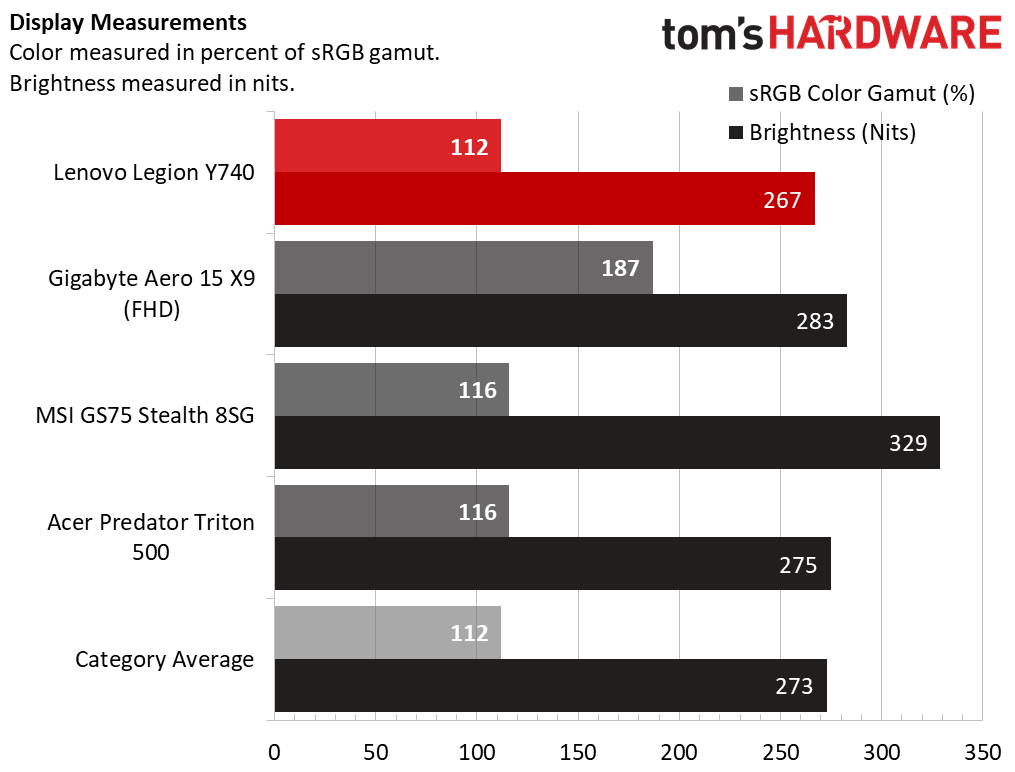Tom's Hardware Verdict
The Lenovo Legion Y740 performs as well as it looks. Unfortunately, some physical flaws, like a nose-shooting webcam and weak questionable keyboard hold it back.
Pros
- +
Above-average frame rates
- +
Sophisticated aluminum build
- +
Customizable RGB keyboard and vents
Cons
- -
Dimmer screen than similarly priced gaming laptops
- -
Keyboard could be more gamer-friendly
- -
Bad webcam positioning
- -
Poor battery life
Why you can trust Tom's Hardware
From its smooth, gray build to its reliable performance whether working or playing, the 15-inch Lenovo Legion Y740 ($1,679.99 / £1,749.99 to start, $1,919.99 / £2,009.99 as tested) is a smooth operator inside and out. The Lenovo Legion Y740 rivals competing Nvidia RTX-powered laptops when it comes gaming performance, while holding its own during productivity tasks.
With an Intel Core i7-8750H CPU, RTX 2070 Max-Q graphics card and 144Hz G-Sync screen, the laptop is clearly ready to game. But a webcam that looks up your nose and a shallow, bendy keyboard will make you think twice about this good-looking gamer.
Design

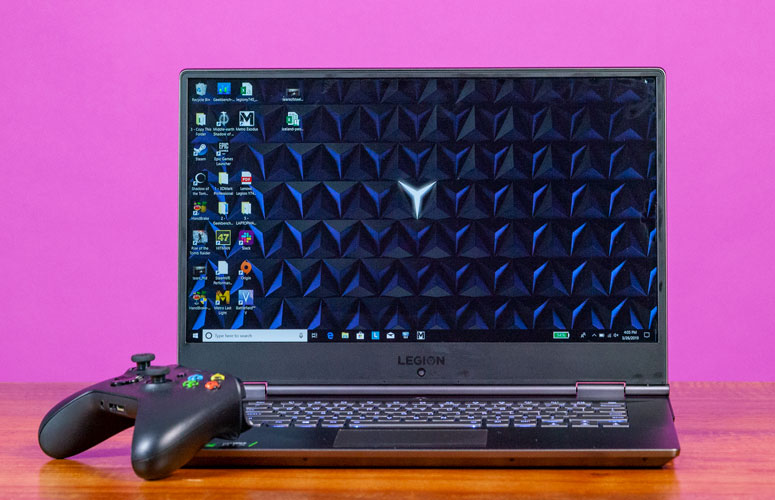


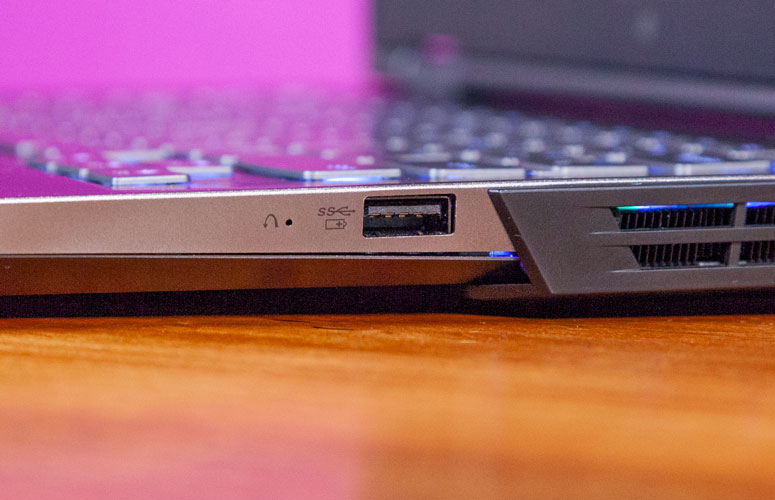
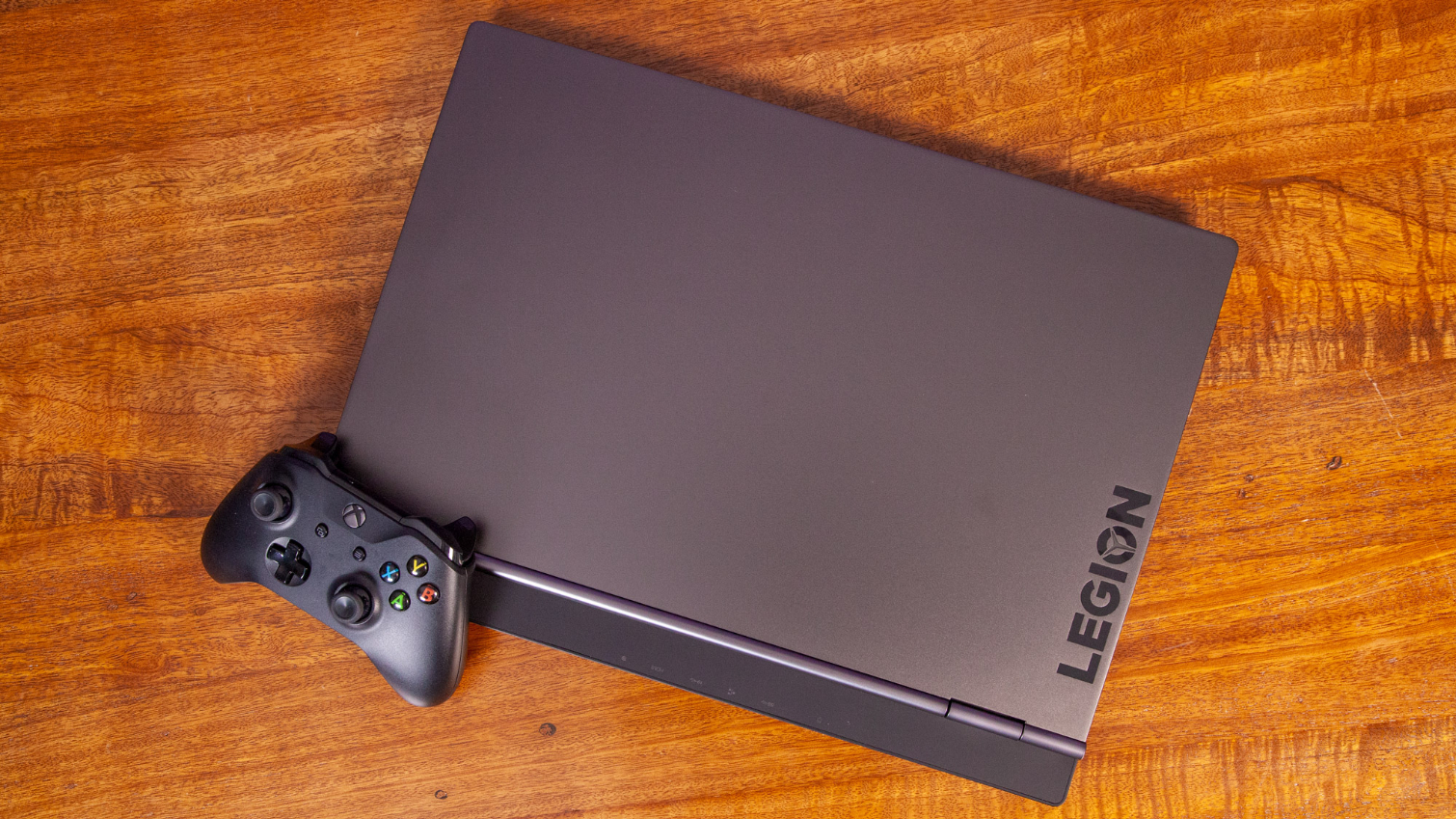
When you first meet the Legion Y540 you might not notice it’s a gaming laptop, but its looks certainly match its larger price tag. The “Iron Grey” (as Lenovo calls it) aluminum chassis has black accents in the form of the lid’s logo, vents and back. The end result is like a little black dress with a twist: simple, classy and versatile with a touch of personality. And like an LBD, its low-key, yet attractive, design makes it fitting for business meetings or showcasing on your living room table, unlike the chunkier, louder looks of many gaming laptops.
Of course, the lid’s Legion branding is a dead giveaway that this is a gaming machine. And if you look closely you can spot additional logos on either side of the hinge and one on the bottom vent. It’s a subtle way of reminding you that you’re team Legion without turning you into a walking advertisement. However, I do wish the lid was less wobbly when open.
The ports on the rear of the system stick out past the hinge, emphasized with relevant icons that light up when activated. This port bank has a connector for the charger, USB 3.1 Gen 2 Type-A, RJ-45 Ethernet, USB 3.1 Gen 1, HDMI 2.0 and Mini DisplayPort. There’s also a security lock here.
On the deck’s left side is a 3.5mm headphone / mic jack and a Thunderbolt 3 port. On the right is a USB 3.1 Gen 1 Type-A that’s always on for charging devices when the laptop’s off and a OneKey Recovery pinhole for activating the included backup and recovery software.
The Legion Y740 looks grown up, but that doesn’t mean it doesn’t know how to have fun. Through included Corsair iCue software you can control RGB lighting on the keyboard and power button, vents on the left and right side of the deck and the small logo in the “O” of “LEGION” written on the lid.
Get Tom's Hardware's best news and in-depth reviews, straight to your inbox.
The display is framed by three narrow bezels and a thick bottom one holding the Legion name and webcam (more on that in the Webcam section below). The deck is simple, featuring only the keyboard, a centrally located power button and “Lenovo” subtly peeking out of the left side toward the bottom corner.
The device measures 14.2 x 10.5 x 0.9 inches (361.4 x 267 x 22.5mm) and weighs 5 pounds (2.3kg). That’s a touch bigger and heavier than the Gigabyte Aero 15 X9 (14 x 9.8 x 0.7 inches, 4.7 pounds) and Acer Predator Triton 500 (14.1 x 10 x 0.7 inches, 4.7 pounds) but a smidge smaller than the MSI GS75 Stealth 8SG (15.6 x 102 x 0.7 inches, 5 pounds).
Lenovo Legion Y740 Specs
| CPU | Intel Core i7-8750H |
| Graphics | Nvidia GeForce RTX 2070 Max-Q (8GB GDDR6) |
| Memory | 16GB DDR4-2666 |
| SSD | 256GB PCIe-NVMe (Samsung) |
| HDD | 1TB 7,200-rpm (Seagate) |
| Display | 15.6-inches FHD (1920x1080) IPS @ 144Hz, G-Sync |
| Networking | Killer Wireless-AC 1550 (2x2)Bluetooth 4.1Ethernet (RJ-45) jack |
| Video Ports | 1x HDMI 2.01x Mini DisplayPort 1.4a |
| USB Ports | 2x USB 3.1 Gen 1 Type-A1x USB 3.1 Gen 2 Type-A1x Thunderbolt 3 |
| Audio | 2x Dolby Atmos speakers1x headphone/mic combo back |
| Camera | 720p |
| Battery | 57 Wh |
| Power Adapter | 230W |
| Operating System | Windows 10 Home |
| Dimensions (WxDxH) | 14.2 x 10.5 x 0.9 inches (361.4 x 267 x 22.5mm) |
| Weight | 5 pounds (2.3 kg) |
| Price (as configured) | $1,919.99 / £2,009.99 |
Gaming, Graphics and VR
Our configuration of the Lenovo Legion Y740 packs plenty of power, thanks to its Nvidia GeForce RTX 2070 Max-Q graphics card with 8GB of GDDR6 memory and Core i7-8750H CPU. I couldn’t wait to see how the Legion Y740 could handle a game like Battlefield V and its use of ray tracing, which promises more realistic reflections and shadows, and DLSS artificial intelligence. Ultimately, our review unit blasted past the average frame rates while going toe-to-toe with other RTX gaming laptops.
When I played Battlefield V at FHD resolution (1920x1080) with DX12 ray tracing on and settings at high, the game ran between 88 and 116 frames per second (fps) but usually stayed in the 90 fps range as I guided Demme Cisse through a Provence, France war zone. When I turned ray tracing off and kept settings at high, the frame rate increased to 90-117 fps but was typically in the 100-110 range.



On the Shadow of the Tomb Raider benchmark (FHD, highest settings, DX12) the Legion pushed out 55 frames per second (fps). That’s better than the FHD score posted by the Gigabyte, which has the same graphics card, and Acer, which has a lesser RTX 2060 (6GB, GDDR6) graphics card. But the MSI did better here, probably thanks to its higher-end RTX 2080 (8GB, GDDR6).
In Hitman (FHD, ultra, DX12), the Legion Y740 output 96 fps, better than the Acer and just managing to outdo the Gigabyte. However, the Legion couldn’t topple the MSI.
During the Grand Theft Auto V benchmark (FHD, very high), the Legion delivered 67 fps, only managing to beat the Gigabyte and falling behind the MSI yet again.
The 3DMark Port Royal benchmark test ray tracing performance. Here, the Legion scored 3,557, which is better than the Acer scored (2,966).
And to stress test the laptop, I ran the Metro Exodus benchmark 15 times on its RTX preset, simulating 30 minutes of heavy gaming. The game played at an average of 85.7 fps, only once falling below 82 fps. During that time, the CPU ran at an average clock speed of 3.7 GHz and was 85.2 degrees Celsius (185.4 degrees Fahrenheit) on average. The GPU ran at an average of 70.4 degrees Celsius (158.7 degrees Fahrenheit).
Productivity Performance
With a 6-core, 12-thread Intel Core i7-8750H CPU, 16GB of DDR4-2666 RAM, a 1TB, 7,200-rpm hard drive from Seagate and 256GB PCIe-NVMe SSD from Samsung, our Legion Y740 is amply equipped to handle average workloads.
Take my 20 browser tabs, including one streaming an episode of Orange Is the New Black off Netflix. Swapping between tabs was usually smooth with the occasional 2-second delay. But I could continuously hear Piper complaining about prison conditions without pause as I clicked around.

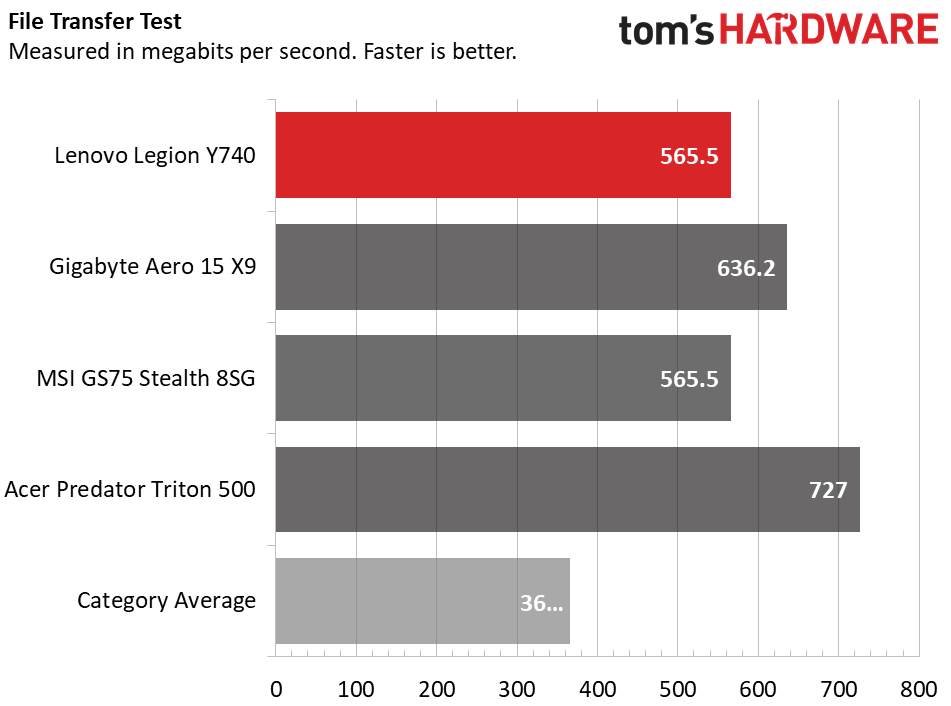

In Geekbench 4.1, an overall performance test, our Legion Y740 posted a score of 21,629, which is better than the average gaming laptop in this price range, as well as the competing Acer machine, which has the same CPU and amount of RAM. The Gigabyte and MSI did better here, but the former has a more powerful i9-8950HK CPU, and they both have twice the RAM as our Legion (32GB each).
The Legion Y740 took 9 seconds to copy 4.97GB of files, a rate of 565.5 MBps. That’s pretty great considering the category average. However, the Acer and Gigabyte were even faster, completing the task in 7 and 8 seconds, respectively.
When it came to the Handbrake test, where the laptop is tasked with transcoding a 4K video to 1080p, the Legion Y740 needed 9 minutes and 23 seconds. That’s pretty swift compared to the average and our comparison sample.
Display
I was excited to check out the 15.6-inch, 1080p screen on the Legion Y740. It’s an IPS panel, which suggests powerful color and the ability to see the action from various angles, with a 144Hz refresh rate, perfect for competitive gamers, and G-Sync for tear-free gaming. Ultimately, the screen did not disappoint.
When I went to Provence, France in Battlefield V, the different colors of foliage stood out, even when they were clouded by fog. Reflections in both the leaves and sweaty faces of soldiers were hard to miss.
A viewing of a 1080p trailer for the live-action Aladdin movie revealed the Legion’s movie-watching potential. Colors were strong, as expected. For example, pink petals falling behind Aladdin stole the scene despite being in the background, and the screen successfully delivered the subtlety of salmon-colored adobe buildings.
I could still enjoy the show when I sat perpendicularly from the laptop. Daytime scenes were glare-free for the most part. Darker scenes showed some glare but were tolerable; in the dark Cave of Wonders I could still tell where Will Smith the Genie’s blue skin ended and black goatee began.
That glare may be due to the Legion Y740 being slightly dimmer (267 nits) than the average gaming laptop in this price range (273 nits). If you need a brighter screen, any of these competing laptops will do the trick.
On the other hand, with 112 percent coverage of the sRGB color gamut matching the category average, the Legion Y740 is right with the pack when it comes to color saturation, except for when compared to the Gigabyte laptop, which has a higher resolution 4K display Pantone-calibrated for color.
Keyboard and Touchpad
The RGB keyboard on the Legion Y540 is not as lush as a mechanical keyboard or even those found in some gaming laptops and it suffers from some flex. It has a shallow 1.25mm of travel and takes 70 grams of force to actuate. It’s a bit shallow and stiff but does produce a pleasant clacking sound with each press.
I couldn’t help but notice the frame around the keys giving way when I typed hard, which is apparently often. This doesn’t bode well for gamers whose intensity is carried over into their physical inputs.
On the 10fastfingers.com typing test, I recorded a rate of 105 words per minute, which is on the high end for me, but with a four percent error rate, double my average. I attribute this to the keyboard being slightly shifted to the right and the keys’ low travel.
The left column of the keyboard contains a button for launching the Lenovo Vantage software. Beneath that is a key for starting Microsoft’s Game bar software, which has a gameplay recorder audio controlled. Underneath that are two macro keys, programmable via Lenovo Vantage, and display brightness controls. Because of this column, the rest of the keyboard is a little off-center.
For RGB fans, Lenovo includes Corsair iCue software for creating and saving different lighting profiles with your favorite per-key lighting effects and customizations, from Rainbow Spiral, to Pulse, to Rain and color pickers. Note, this software also controls RGB for the vents and Legion logo on the lid. I have to say RGB looks less gaudy when framed by subtle aluminum.
The surface of the 4 x 2-inch touchpad is Mylar, a polyester film. It’s super smooth and handled all Windows Gestures without fail. Adding to that experience, surprisingly, are its two discrete buttons. They have a deep press for a touchpad, just over 1.1mm, so hitting them was quite satisfying.
Audio
The Dolby Atmos speakers on the Legion Y740 are fitting for this premium machine. The laptop also comes with Dolby Atmos for Gaming audio software, which offers six different profiles, including Game, Dynamic and Music, some with tweakable sliders.
With Battlefield V, the various traumatizing sounds all had their say. While gunshots boomed deeply, soldiers’ voices were audibly layered on top, from screams to French yelling. Their voices were especially distinct when I had Dolby Atmos’ Gaming profile enabled.
To further check the Legion’s sound, I turned up ABBA’s “Dancing Queen.” The underlying piano riff was clear, and I could hear the different melodic voices forming the harmony. At max volume, it was enough to start a dance party in our small lab without distortion. Dolby Atmos’ Dynamic seemed to be the preferred profile, as the Music one made the song sound muffled.
Upgradeability
If you want to upgrade the Legion Y740, you’ll first have to remove 11 Phillips-head screws from the bottom. After that, the bottom pops off pretty easily.
You can swap out the hard drive by removing two Philips head screws and the heat shield. The SSD, topped with a sticky thermal pad, is also secured with a single Phillips screw; although, our review unit had a Lenovo sticker over it. The Killer WiFi module should also be replaceable, but a small thermal pad near the Philips screw securing it makes it a little challenging.
The RAM is hidden by a silver cover, possibly for fighting heat. That means it’ll take an extra step to swap the memory out. By sticking a screwdriver into the four corners of the metal cover, we were able to pry the metal shield off. Beneath were two RAM modules that you can pop out of their individual brackets.
Battery Life
With its slimmer build and gaming focus, it’s not surprising to see the Legion Y740 put up less-than-stellar battery life results, but it was disappointing, even for a gaming laptop.
Our battery test continuously browses the web, streams videos and runs OpenGL tests. The Legion lasted just 2 minutes and 16 seconds, much shorter than our competitors here and about 2 hours shorter than the average gaming laptop in this price range.
Heat
To see how warm the Legion gets during typical use, we checked its temperature immediately after streaming 15 minutes of HD video from YouTube. The hottest point was the bottom at 40.9 degrees Celsius (105.6 degrees Fahrenheit). The spot between the G and H keys was 33.3 degrees Celsius (91.9 degrees Fahrenheit), and the touchpad was just 28.9 degrees Celsius (84 degrees Fahrenheit).


We also checked its heat after a 15 minute session of Battlefield V. The bottom reached 39.8 degrees Celsius (103.6 degrees Fahrenheit). Meanwhile, the spot between the G and H keys was a roasting 44.5 degrees Celsius (112.1 degrees Fahrenheit), and the touchpad stayed cool, peaking at just 22.1 degrees Celsius (71.8 degrees Fahrenheit).
Webcam
The 720p webcam on the Legion Y740 is almost impressive if it weren’t for its unfortunate location and washing out of colors. It lives in the center of the thick bottom bezel, which guarantees an awkward upshooting angle. I had to tilt the lid back quite a bit in order to get my entire mug into view.


At 720p resolution, the image quality isn’t particularly sharp, but it lacked the heavy visual noise prominent in many laptop webcams. I took the first photo above with a sunny window behind me, and my office’s white ceiling and the area closest to the window were almost completely washed out. When I took a second photo facing the window, things were less faded, but I lost the color accuracy in my skin. In any scenario, I don’t recommend using the webcam with the laptop resting on your legs (like in the second picture), unless you prefer an elongated torso.
Software and Warranty
The Legion Y740 comes with a lot of software pre-installed, some helpful for gaming, others not.
In addition to controlling the RGB lighting for the keyboard and power button, side vents and lid’s logo, iCue software has a dashboard offering a (very) quick overview of the CPU, GPU and battery.
Lenovo Vantage also provides quick hardware info, as well as easy access to driver updates, running systems diagnostics, getting support and more.
However, I could do without LenovoUtility and Windows 10 bloatware, like Candy Crush Friends, Candy Crush Saga, Cooking Fever, Fitbit Coach, Groove Music, LinkedIn, Phototastic Collage and Skype.
Configurations
Our configuration of the Legion Y740 is the priciest in the U.S. It has an i7-8750H CPU, RTX 2070 Max-Q (8GB GDDR6) graphics card, 16GB of DDR4-2666 RAM, a 1TB, 7200-RPM HDD and 256GB PCIe-NVMe SSD. It’s $1,919.99 / £2,009.99.
The cheapest version starts at $1,679.99 / £1,749.99 for the same CPU and RAM as our review unit but a lesser RTX 2060 GPU and only a 256GB SSD for storage.
In the U.S. there’s also a customizable option starting at $1,739.99 with an i7-8750H, RTX 2060 Max-Q GPU, 16GB RAM and a 1TB HDD. U.S. shoppers also have a $1,749.99 choice that was out of stock at the time of writing. But if you can get that version, you’ll end up with the same specs as our review unit but with an RTX 2060 Max-Q graphics and a 512GB SSD.
If you want a bigger screen, 17-inch versions of the Legion Y740 start at $1,839.99 / £1,849.99.
The Legion Y740 comes with a one-year warranty.
Bottom Line
Lenovo delivers an attractive device in the Legion Y740 that is mature and appealing in its design and performance. When it comes to gaming, its RTX graphics card smashes average frame rates among other gaming laptops in this price range. And productivity performance is sufficient for average tasks, like heavy web browsing while streaming video.
However, the laptop has a few flaws, which is unfortunate at $1,919.99. The keyboard is shallow, and I can see the frame giving when I typed. Plus, the webcam is in a position that flatters no one.
If you’re looking for an alternative, our configuration of the MSI GS75 Stealth, with an RTX 2080 Max-Q, i7-8750H, 32GB RAM and 512GB SSD put up better frame rates in our gaming benchmarks. Its larger 17-inch screen has a much brighter panel and is slightly more colorful than our Legion’s display, but the laptop is also pricier. And for better productivity, the Gigabyte Aero 15 X9 gets it done with its i9-8950HK and 32GB of RAM but, again, a higher price.
But if you don’t want to pay any more for extra frame rates and don’t need the brightest screen or top-level productivity potential, the Legion Y740 is a great buy.
MORE: Best Gaming Laptops
MORE: Laptop Reviews
MORE: All Laptop Content
Photo Credits: Tom's Hardware

Scharon Harding has over a decade of experience reporting on technology with a special affinity for gaming peripherals (especially monitors), laptops, and virtual reality. Previously, she covered business technology, including hardware, software, cyber security, cloud, and other IT happenings, at Channelnomics, with bylines at CRN UK.




